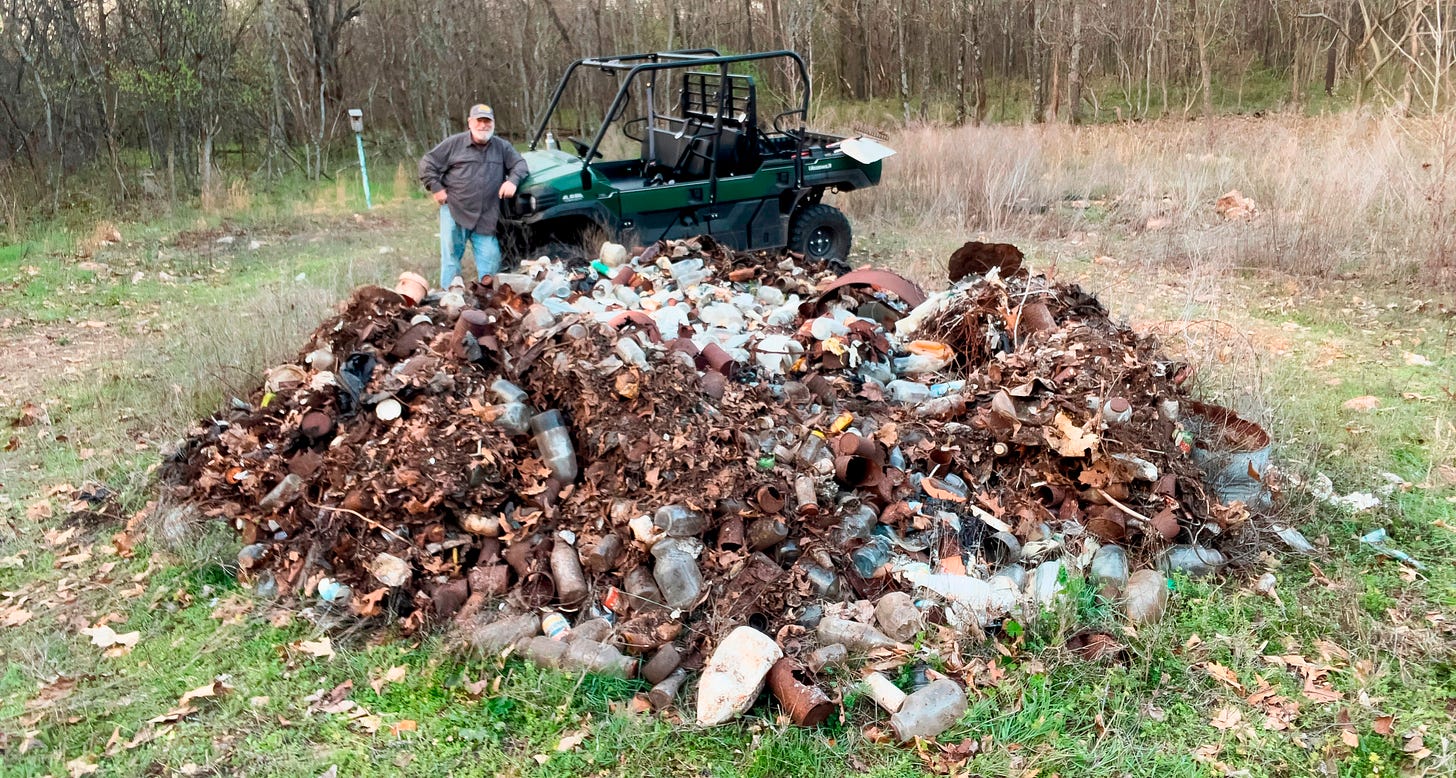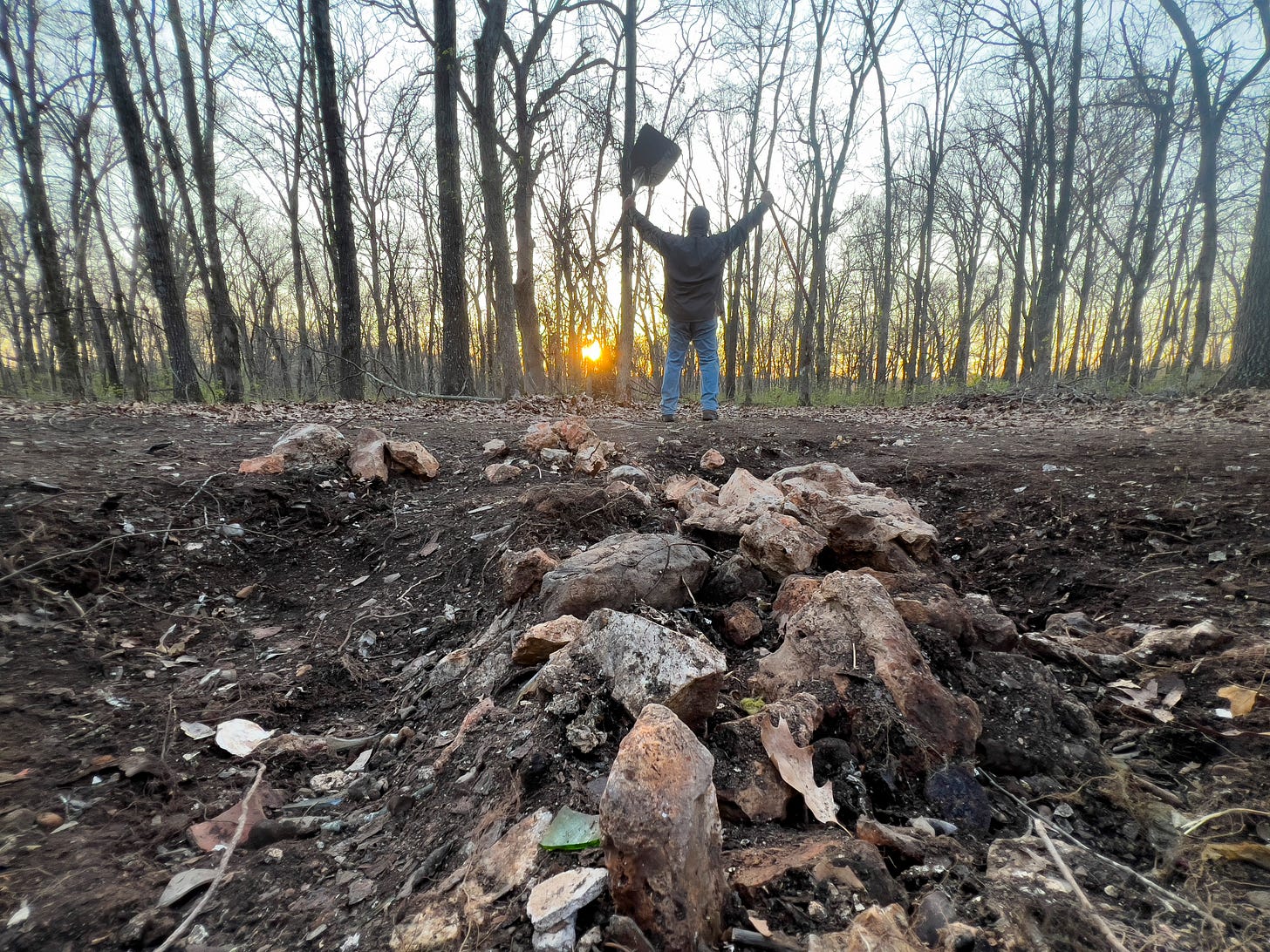Creek Bends: Earth Day and the big ugly trash heap
Hand-shoveling 11 cubic yards of garbage provides time to reflect

Bury a bottle of Brut cologne in the forest, give it 40 years, and you know what it smells like when you dig it up?
Something alcohol-ish, mixed with dirt and a hint of the 1970s.
Aside from a neat collared snake and a few surprising items, like a stack of about 200 Pryor Bowling Alley score cards—remember those overhead projector score sheets?—the (many) bottles of Brut were the more pleasant of things I found among about 11 yards of trash in a garbage heap on the oak ridge at Snake Creek.
Last week, I finished removing it. One scoop, one handful, one load at a time. We went for a low-cost, low-impact approach, and over time, it got done.
The trash heap was one of the first “gotta do that” things I felt when our favorite landowners at Snake Creek said they wanted to return the 50 acres to a productive, invasive-free, and enjoyable habitat for pollinators and wildlife.
The first season on the ridge, I used it like a navigational beacon at night and on early morning walks to hunting spots. But every time I looked at it, part of me cringed.
It got so that damned trash heap was like a briar thorn busted off under my fingernail. Walking past, I couldn’t stand it, so I started picking away at it. It was a bag here, a backpack load there, at first. Then I got serious about it and kept at it, picking away, until last week. It was finally done—or, out of the woods at least. We haven't hauled it to a landfill yet.
Cleaning up America
I guess that's what comes of being a child of the 1960s and 1970s. I was eight years old when the first Earth Day took place, in April 1970, before there was a Clean Water Act, a Clean Air Act, or an Environmental Protection Agency.
Back then, canning and bottling companies worried that hippies would persuade the government to ban disposable containers, which would cost them money, so they supported the Keep America Beautiful campaign. Blame the people who litter, not the people who make containers; that was essentially their goal. Iron Eyes Cody, a Sicilian dressed up as a Native American, became “The Crying Indian” in a history-making television ad campaign.
Every American my age remembers that ad. It was always on.
That campaign, driven by less-than-pure motivation, combined with grassroots concern and a growing awareness of catastrophic environmental damage, smog, and industrial pollution brought on by unwise practices rushed through to satisfy a growing and hungry country, led to an explosive public display on April 22, 1970.
Good thing that tradition continues. Some designated days are helpful reminders to pause and take a moment to reflect. Some more than others, but who am I to dismiss the relevance of days like May The Fourth? (gratuitous Star Wars reference, you’re welcome)
An item in my last load, found deep in the trash pile, was a True Value Diet Cola can with an old pop top rattling inside - the grip-and-rip kind, discontinued in 1983. It had me humming “Margaritaville” the rest of the afternoon, and if you don’t get that reference, may the ghost of Jimmy Buffett haunt your dreams.
“Sugar Free” and “Carmel Coloring” it boasted on the side of the can.
Yummy.
Stamped on the top, the standard advice. “Don’t Litter” and “Please Recycle.”
Forty-five years later, it’s headed for a landfill.
Later, it occurred to me that I should have set it aside and put it in a recycling bin. That would have been a moment. If I come across it again, I will. Should be near the top of the heap somewhere.
Leave it better than you found it
So, how far have we come? Really? In this Keep America Beautiful idea, some 40 or 50 years later?
We do still love our disposable packaging. We love it a lot.
The 15-year-old in me who used to repeat the slogan, “Give a Hoot! Don’t Pollute!” chuckled at finding that old cola can with those slogans on top. The 62-year-old me appreciated that at least this pile of trash was roughly two-thirds glass, metal, and aluminum containers. Still, 30 percent plastic or petroleum-based products was plenty.
Our issues have evolved. More people are aware of environmental concerns. At least I think so. We can debate whether we’ve truly made an improvement. The problems are complicated.
It’s easy to be discouraged in a political era where the head of the EPA equates that awareness with “wokeness,” which is considered a bad thing. For now, deregulation appears to be winning the day politically. Agency overstepping is an issue, but deregulation also can go too far. It’s tough to celebrate an evolution from apathy to denialism.
In the early 1970s, I was young enough that most significant political developments were beyond my comprehension. As a result, I matured with the general public expectation that corporations and agricultural practices should embrace concepts like sustainable development.
A rancher in South-central Oklahoma reflected on this with me at one point, as he explained the changes in his farming practices from his ancestors, who settled on that land before statehood. “They used to do whatever they needed to do to put food on the table and survive and raise a family. That was the only priority,” he said. “Now we have options to live a comfortable life and take care of what we have at the same time.”
Crazy, the things you uncover in the woods and where they take your thoughts.
I was only eight years old on the first Earth Day. I was raised knowing that littering was a bad thing to do in Iowa farm country, with a father who preached, “leave it better than you found it” in every task we undertook.
Now that I’m the age my father was then, I shoveled 11 cubic yards of trash out of a 40-year-old pile in the middle of a pleasant Ozarks Uplift ridge and left a depression with several large boulders in the center.
The leaves will blow back in and cover it up. The buckbrush and greenbriar will grow back. Trees will sprout, and the garbage pile hole will be just another dip in the landscape of unknown origins.
Those of us who know the ridge will know it’s the one with the big pile of rocks in the middle instead of a water heater.
And now, when I walk past, it will feel good to reflect, because it’s better than how we found it.






Kelly,
Congratulations on your cleaning up a little part of the realm.
I volunteer at Oxley Nature Center. Seeing the trash along the banks of Coal Creek and Sherry Lake, I asked if I could help clean up the banks. After 3 years, with my efforts, help from friends, and organized cleanups park volunteers, noticeable improvement has been made. Like an adopted highway section, the effort will never end.
Hit return inadvertently.
Charlie Transue
Oxley Nature Center Volunteer
Tulsa, Oklahoma